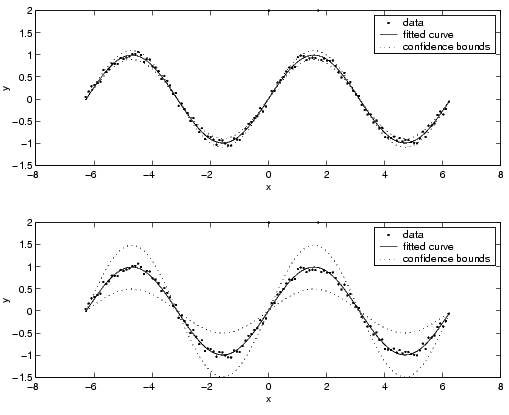Syntax
plot(fresult)
plot(fresult,xdata,ydata)
plot(fresult,xdata,ydata,'s')
plot(fresult,'s1',xdata,ydata,'s2')
plot(fresult,xdata,ydata,outliers)
plot(fresult,xdata,ydata,outliers,'s')
plot(...,'ptype1','ptype2',...)
plot(...,'ptype1','ptype2',...,conflev)
h = plot(...)
where
fresult |
A fit result object |
xdata |
A column vector of predictor data |
ydata |
A column vector of response data |
s,s1,s2 |
The plot symbols, plot colors, and line type |
outliers |
A vector of outliers |
'ptype' |
The plot type. You can specify multiple plot types as a cell array of strings. |
conflev |
The confidence level |
h |
A vector of plot handles |
Description
plot(fresult) plots the fit result object fresult. fresult is a fit result object generated by the fit function.
plot(fresult,xdata,ydata) plots the fit result object, the predictor data specified by xdata, and the response data specified by ydata.
plot(fresult,xdata,ydata,'s') plots the predictor and response data using the color, symbol, and line type specified by the string s. Refer to the built-in plot function for color, symbol, and line type options.
plot(fresult,'s1',xdata,ydata,'s2') plots the fit result object using the color, symbol, and line type specified by the string s1, and plots the predictor and response data using the color, symbol, and line type specified by the string s2.
plot(fresult,xdata,ydata,outliers) plots the outliers specified by outliers in a different color. outliers must be the same size as xdata and ydata. You identify data points as outliers with the excludedata function.
plot(fresult,xdata,ydata,outliers,'s') plots the outliers using the color, symbol, and line type specified by the string s.
plot(...,'ptype1','ptype2',...) plots the plot types specified by ptype1, ptype2,.... ptype can be a single plot type or multiple plot types, which you can specify as a cell array of strings. For one plot type or none (the default), plot behaves like the built-in plot command and draws into the current figure and axes. This way, you can use commands like subplot and hold to arrange plots in a figure window and to superimpose multiple fits into the same graph. For multiple plot types, plot uses subplot to create one set of axes per plot type. The supported plot types are given below.
| Plot Type | Description |
| fit | Plot the data and the fit (default) |
| predfunc | Plot the data and the fit with prediction bounds for the function |
| predobs | Plot the data and the fit with prediction bounds for a new observation |
| residuals | Plot the residuals. The fit corresponds to the zero line |
| stresiduals | Plot the standardized residuals. The fit corresponds to the zero line. Standardized residuals are the ordinary residuals divided by their standard deviation. Standardizing puts all residuals on a common scale (units of standard deviations) and makes it easier to quantify how far a point is from the fitted curve. |
plot(...,'ptype1','ptype2',...,conflev) plots prediction bounds with the confidence level specified by conflev. Specify a value between 0 and 1. The default value is 0.95 for 95% confidence levels.
h = plot(...) returns a vector of handles to h.
Example
Create a noisy sine wave on the interval [-2\(\pi\), 2\(\pi\)] and add two outliers with the value 2.
rand('state',2);
x = (-2*pi:0.1:2*pi)';
y = sin(x) + (rand(size(x))-0.5)*0.2;
y(ceil(length(x)*rand(2,1))) = 2;
Identify outliers that are outside the interval [-1.5, 1.5] using the range method.
outliers = excludedata(x,y,'range',[-1.5 1.5]);
Create a custom fit type, define fit options that exclude the outliers from the fit and define reasonable starting values, and fit the data.
ftype = fittype('a*sin(b*x)');
opts = fitoptions('Method','NonLinear','excl',outliers,...
'Start',[1 1]);
fit1 = fit(x,y,ftype,opts);
Plot the data, the fit to the data, and mark the outliers.
subplot(2,1,1)
plot(fit1,'k-',x,y,'b.',outliers,'ro');
Plot the residuals.
subplot(2,1,2)
plot(fit1,'k-',x,y,'b.','residuals');

Plot 99% confidence and prediction bounds for the function and for a new observation.
plot(fit1,'k-',x,y,'b.','predf','predo',0.99);
